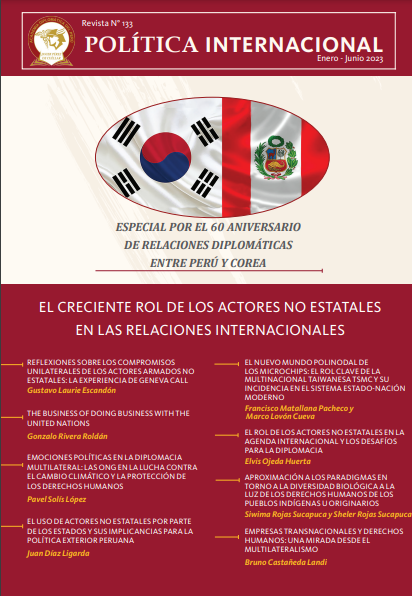Strategies to reduce the digital divide in Peru: lessons from the Republic of Korea.
DOI:
https://doi.org/10.61249/pi.vi133.71Keywords:
Strategy, Inclusion, digital divide, Peru, KoreaAbstract
Information technologies have become catalysts of the economy, especially during the pandemic. Developing countries have been lagging behind developed ones because of their inequal access in terms of infrastructure, use, and skills needed to benefit from these technologies. Governments should establish strategies to reduce this gap and achieve the digital inclusion of their citizens. This study analyzes the current status of the digital divide of Peru, and assesses the policies established by the Republic of Korea to reduce this gap. Korea was chosen as benchmark because it is one of the leading countries in technology. Results highlight the complex nature of this phenomenon, and provide the Peruvian government with recommendations based on the best Korean practices.
Downloads
References
Anderson, B., & Tracey, K. (2001). Digital living. American Behavioral Scientist, 45(3), 456–475.
Banco Mundial. (s.f.). World development indicators. Recuperado de http://data.worldbank.org/?display=graph
Barzilai-Nahon, K. (2006). Gaps and bits: Conceptualizing measurements for digital divide/s. The Information Society, 22(5), 269–278.
Brandtzæg, P. B., Heim, J., & Karahasanović, A. (2011). Understanding the new digital divide - A typology of Internet users in Europe. International Journal of HumanComputer Studies, 69(3), 123–138
Cámara Peruana de Comercio Electrónico. (2021). Reporte oficial de la industria de Ecommerce en Perú. Recuperado de https://www.capece.org.pe/wp-content/uploads/2021/03/Observatorio-Ecommerce-Peru-2020-2021.pdf
Chinn, M. D., & Fairlie, R. W. (2007). The determinants of the global digital divide: A cross-country analysis of computer and Internet penetration. Oxford Economic Papers, 59(1), 16–44.
CIA. (s.f.). The World Factbook. Recuperado de https://www.cia.gov/the-world-factbook/
Forman, C., Goldfarb, A., & Forman, C. (2005). How do industry features influence the role of location on Internet adoption? Journal of the Association for Information Systems, 6(12), 383–408.
Freeman, C. (2001). A hard landing for the ‘New Economy’? Information technology and the United States national system of innovation. Structural Change and Economic Dynamics, 12(2), 115–139.
Frieden, R. (2005). Lessons from broadband development in Canada, Japan, Korea and the United States. Telecommunications Policy, 29(8), 595–613.
Goldfarb, A., & Prince, J. (2008). Internet adoption and usage patterns are different: Implications for the digital divide. Information Economics and Policy, 20(1), 2–15.
Im, Y. (2002). ICT education to narrow digital divide in South Korea. Hanyang Cyber University: Seúl, Corea del Sur.
Jamil, S. (2021). From digital divide to digital inclusion: Challenges for wide-ranging digitalization in Pakistan. Telecommunications Policy, 45(8), 102206.
Livingstone, S., & Helsper, E. (2007). Gradations in digital inclusion: Children, young people and the digital divide. New Media & Society, 9(4), 671–696.
Ministerio Coreano de Economía y Finanzas. (s.f.). New Deal. Recuperado de https://english.moef.go.kr/main.do
Ministerio de Educación del Perú. (2022). 124,533 estudiantes interrumpieron su educación en el 2021 debido a la pandemia. Recuperado de https://www.gob.pe/institucion/minedu/noticias/607069
OECD. (2001). Understanding the digital divide. Organisation for Economic Co-Operation and Development: Paris, Francia.
Orbicom. (2003). Monitoring the digital divide... and beyond. Red de las Cátedras UNESCO de Comunicación: Montreal, Canadá.
Peter, J., & Valkenburg, P. M. (2006). Adolescents’ internet use: Testing the “disappearing digital divide” versus the “emerging digital differentiation” approach. Poetics, 34(4–5), 293–305.
Presidencia del Consejo de Ministros. (2021). PCM inaugura Centro de Cooperación en Gobierno y Transformación Digital Perú-Corea para acelerar la inclusión digital de toda la ciudadanía. Recuperado de https://www.gob.pe/institucion/pcm/noticias/544562
Rice, R. E., & Katz, J. E. (2003). Comparing internet and mobile phone usage: Digital divides of usage, adoption, and dropouts. Telecommunications Policy, 27(8–9), 597–623.
Selwyn, N., Gorard, S., & Furlong, J. (2005). Whose Internet is it anyway? European Journal of Communication, 20(1), 5–26.
The Gobal Economy. (s.f.). Peru: Education spending, percent of GDP. Recuperado de https://www.theglobaleconomy.com/Peru/Education_spending/
UIT. (2003). Broadband Korea: Internet case study. Unión Internacional de Telecomunicaciones: Ginebra, Suiza.
UIT. (2009). Measuring the information society 2009. Unión Internacional de Telecomunicaciones: Ginebra, Suiza.
UIT. (2010). Measuring the information society 2010. Unión Internacional de Telecomunicaciones: Ginebra, Suiza.
UIT. (2011). Measuring the information society 2011. Unión Internacional de Telecomunicaciones: Ginebra, Suiza.
UIT. (2012). Measuring the information society 2012. Unión Internacional de Telecomunicaciones: Ginebra, Suiza.
UIT. (2013). Measuring the information society 2013. Unión Internacional de Telecomunicaciones: Ginebra, Suiza.
UIT. (2014). Measuring the information society 2014. Unión Internacional de Telecomunicaciones: Ginebra, Suiza.
UIT. (2015). Measuring the information society 2015. Unión Internacional de Telecomunicaciones: Ginebra, Suiza.
UIT. (2016). Measuring the information society 2016. Unión Internacional de Telecomunicaciones: Ginebra, Suiza.
UIT. (2017). Measuring the information society 2017. Unión Internacional de Telecomunicaciones: Ginebra, Suiza.
UIT. (2018). Measuring the information society 2018. Unión Internacional de Telecomunicaciones: Ginebra, Suiza.
van Deursen, A., & van Dijk, J. (2014). The digital divide shifts to differences in usage. New Media & Society, 16(3), 507–526.
van Dijk, J. (2006). Digital divide research, achievements and shortcomings. Poetics, 34(4–5), 221–235.
Venkatesh, V., & Sykes, T. A. (2013). Digital divide initiative success in developing countries: A longitudinal field study in a village in India. Information Systems Research, 24(2), 239–260.
Vigdor, J. L., Ladd, H. F., & Martinez, E. (2014). Scaling the digital divide: Home computer technology and student achievement. Economic Inquiry, 52(3), 1103–1119.
Zheng, Y., & Walsham, G. (2021). Inequality of what? An intersectional approach to digital inequality under Covid-19. Information and Organization, 31(1), 100341.
Downloads
Published
How to Cite
Issue
Section
License
Copyright (c) 2023 Christian Fernando Libaque-Saenz

This work is licensed under a Creative Commons Attribution 4.0 International License.








